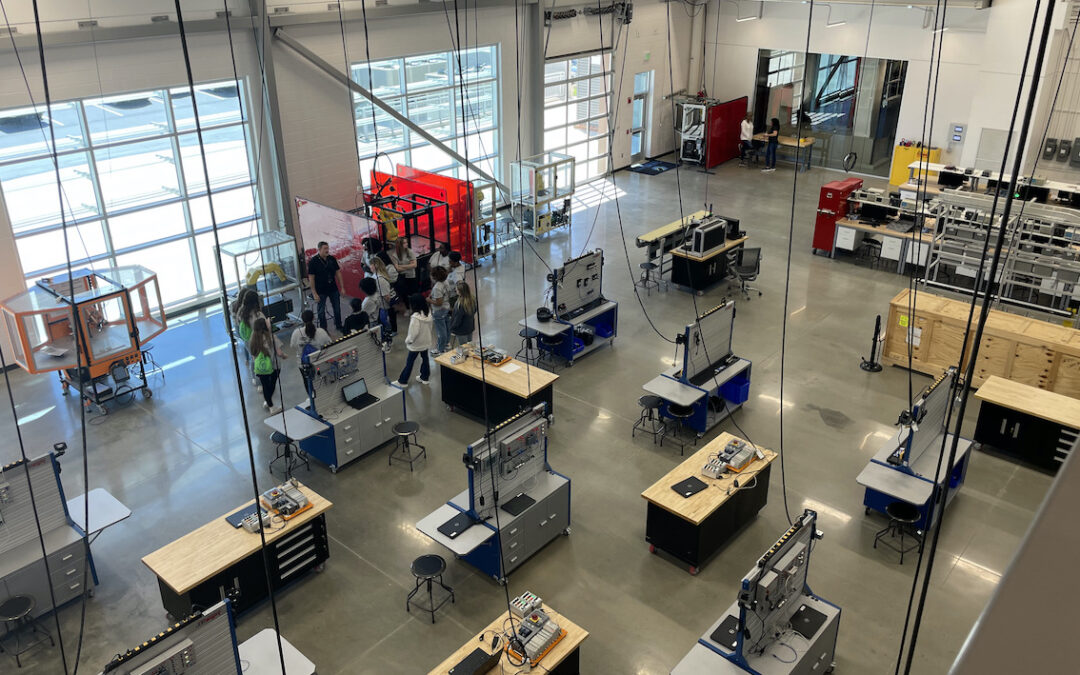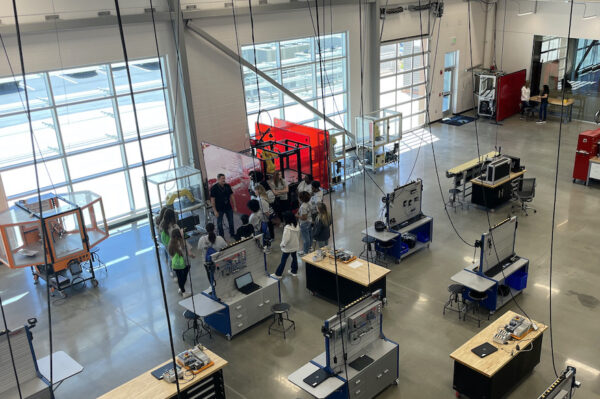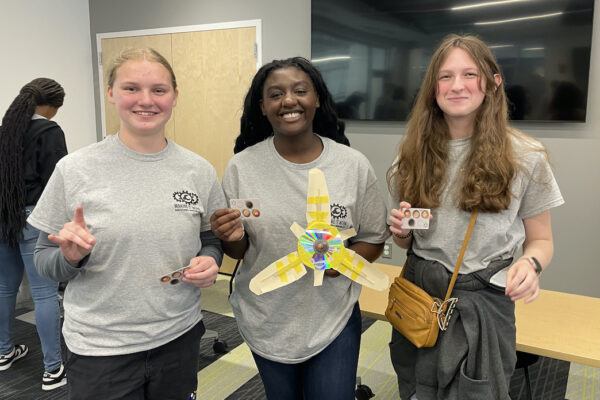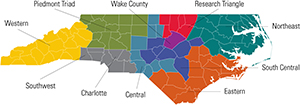
Chris McGraw (left) and Kevin Grayson (right) with the first-place team in the engineering windmill competition.
Rising From the Ashes
Cleveland County has had a rough go of things. The southwestern North Carolina county was one of the hardest hit by the Great Recession and only started gaining footing in 2014. For rural North Carolina, the Great Recession of 2007-2009 was the most severe economic collapse since the Great Depression in the 1930s.
As a Cleveland County native and Cleveland County Economic Development Partnership (CCEDP) director of business services, Brandon Ruppe felt the weight of a crashed economy and the struggle of his peers. “In 2009, when millennials graduated from high school in Cleveland county, we hit our record unemployment at 17%. We lost textiles”, Rupee stated soberly. “There were no job opportunities, let alone manufacturing growth in our community.” As a result of the hemorrhaging of jobs, the population of Cleveland County decreased rapidly.
But now is a time for renewed hope in Cleveland County, 6.5 billion dollars of capital investment in Cleveland County and over 6,000 new jobs have been created. As the gateway between Charlotte and Atlanta, Cleveland County promotes itself as a prime location for manufacturing organizations. Cleveland County launched the first “Making it Work” Manufacturing & Engineering Fair in 2012 to encourage students to consider careers in engineering and manufacturing and remedy the lingering economic and workforce recruitment difficulties.
Making It Happen
Engineering and manufacturing have always been closely linked, with engineers continuously designing and improving the machines and tools used in production. However, with the rapid pace of technological development, the role of engineering in manufacturing is set to change dramatically in the coming years. The “Make It Work” event aims to change the young generation’s perception of engineering and manufacturing, make them aware of the changes happening in the sector and give them the advice they’ll need to excel in their career path.
In 2015, the torch to oversee the “Making It Work” event was passed to Rupee. “I’ve managed the ‘Making It Work’ event for over five years and have taken it with me across the organizations I’ve worked for because it works so well. It doesn’t belong to any one entity. It’s a collaboration between Cleveland Community College (CCC), Cleveland County Economic Development Partnership (CCEDP) and the Cleveland County private sector. The event has transformed over time. Every year we improve it based on feedback from vendors and students,” Ruppe said. Ruppe has expertise in aiding companies with hiring, retaining, and nurturing employees. His specialization is helping businesses to establish talent pipelines and successfully integrate into the Cleveland County community. Talent attraction and retention is one of the critical issues faced in Cleveland County and across America. He has devoted himself to assisting in cultivating reliable, homegrown workforce talent.
The fair is generally a three-phase day with over 200 high school juniors and seniors from Cleveland, Rutherford and surrounding counties involved. The first phase includes an industry tour with students visiting a local manufacturing plant near their high school. Next is the industry expo. The students are given bingo cards which receive a mark for every vendor they meet with. They then turn their completed bingo cards in for a door prize. “Every year, the most consistent feedback from the students is that the expo is their favorite part and the companies are always surprised with how engaged the students are; we even have to pull them away from the vendors to remind them of the next event,” Rupee stated.
 The final and most hands-on event of the day is the engineering competition hosted by NC State University. NC State Industry Expansion Solutions (IES) Chris McGraw and Kevin Grayson lead the competitions. Regional manager Jennifer Fielder was present to witness the contest. Divided into groups of three or four, the students were asked to build a power-generating windmill from nothing but a CD, popsicle sticks, scissors, post-it notes and a glue stick. Though they were minimally supplied and only given 45 minutes to complete the challenge, the competition yielded remarkable results. “When they were ready to test it, Chris McGraw and I were set with a power meter to measure the electricity generated by the hand-created windmills. We found the highest generated power was in the 500 watts range,” said Grayson. The winning team created a popsicle windmill that emanated enough watts to charge four car batteries.
The final and most hands-on event of the day is the engineering competition hosted by NC State University. NC State Industry Expansion Solutions (IES) Chris McGraw and Kevin Grayson lead the competitions. Regional manager Jennifer Fielder was present to witness the contest. Divided into groups of three or four, the students were asked to build a power-generating windmill from nothing but a CD, popsicle sticks, scissors, post-it notes and a glue stick. Though they were minimally supplied and only given 45 minutes to complete the challenge, the competition yielded remarkable results. “When they were ready to test it, Chris McGraw and I were set with a power meter to measure the electricity generated by the hand-created windmills. We found the highest generated power was in the 500 watts range,” said Grayson. The winning team created a popsicle windmill that emanated enough watts to charge four car batteries.
Kevin Garcia-Diaz, one of the seniors on the 1st place team, remarked, “It was a great opportunity to see different creativity of people create various solutions to the same problem.” Garcia-Diaz wasn’t the only student inspired by the event. Loree Blue, the marketing director for IES, noted that she overheard one of the students saying, “I think I want to be an engineer now!”
Though engineering is one of the event’s core focuses, it’s not lost on the organizers that engineering may not be for everyone. Expo vendors also inform the region’s brightest young minds about the vast diversity of career opportunities available in Cleveland County manufacturing operations. As a “Making It Work” manufacturing representative, George Lynn, the Nippon Electrical plant manager, has been heavily involved in the event since the beginning. He prides himself on being one of the first collaborating members. “The event is heavily focused on engineering but we understand engineering is not a path for everyone. There are other career paths within manufacturing like technology, science, mathematics, accounting and marketing-based careers. This event teaches students that manufacturing is more than just assembly lines and “outdated” work.”
Crunching The Numbers
Surveys taken to evaluate the fair’s effectiveness showed a shift toward positive attitudes regarding a vocation in manufacturing. “I can’t do anything without taking data!” bragged Ruppe. What the surveys found was that there was a 30% improvement in their perception of manufacturing. There were 20 students before the event who didn’t consider a manufacturing career. By the end of the event, only two students said they didn’t consider a career in manufacturing. “Even the student who was on the fence about pursuing a career in manufacturing had a spike in interest,” explained Ruppe.
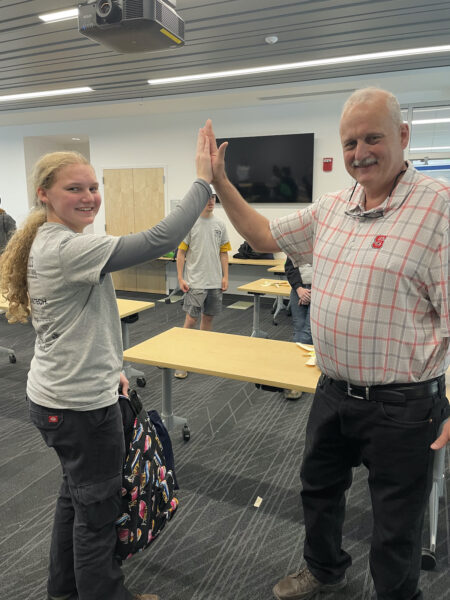 Manufacturing in Cleveland County has a strong future ahead. Those at CCEDP are optimistic about cultivating skilled talent locally to keep manufacturers competitive, adopting new technologies, bridging the gap of an aging workforce and expanding their manufacturing base. When asked what Ruppe wishes the students take away from the “Making It Work” event, he said, “I want them to know that this community has good, fulfilling jobs where the cost of housing is 49% lower than the national average and the cost of living is 10% lower than the national average. You can live in rural North Carolina and make a great living. ”
Manufacturing in Cleveland County has a strong future ahead. Those at CCEDP are optimistic about cultivating skilled talent locally to keep manufacturers competitive, adopting new technologies, bridging the gap of an aging workforce and expanding their manufacturing base. When asked what Ruppe wishes the students take away from the “Making It Work” event, he said, “I want them to know that this community has good, fulfilling jobs where the cost of housing is 49% lower than the national average and the cost of living is 10% lower than the national average. You can live in rural North Carolina and make a great living. ”

